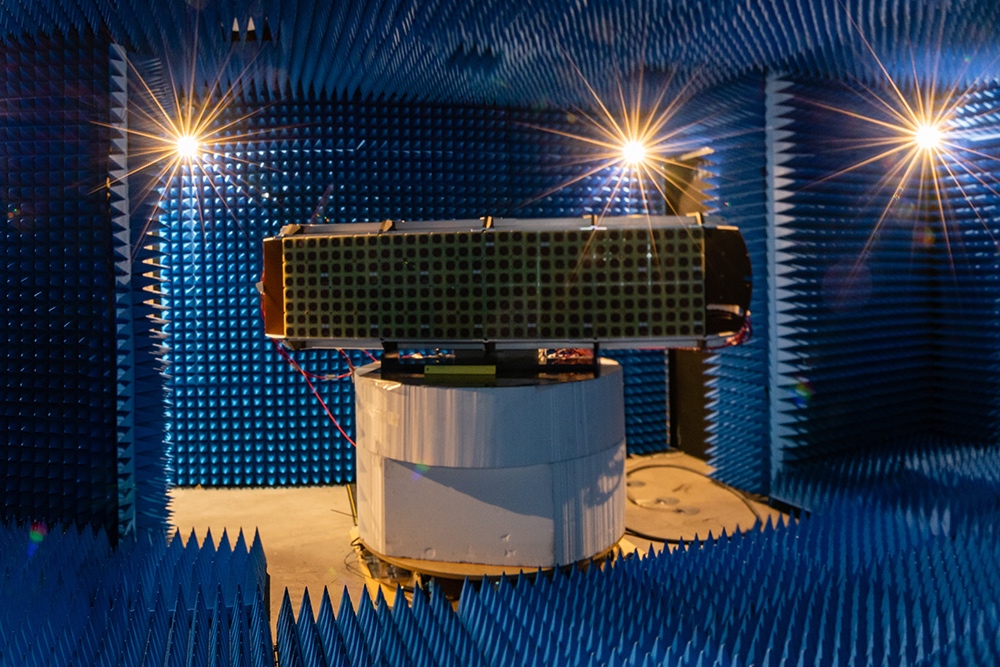In the near future, your phone may take its 5G signal from the sky instead of a nearby mast on the ground. It’s an innovative way to solve the problem of increasing connectivity without relying on thousands of terrestrial cell towers. The concept is known as a High Altitude Platform Station (HAPS), and it essentially takes the cell tower from the ground and puts it in the sky.
The latest HAPS project to be unveiled is from Stratospheric Platforms and Cambridge Consultants. Today, the pair revealed the core of its efforts, a special antenna and unmanned aircraft, which it has been working on confidentially for the last four years.
How will it work?
Instead of talking to a nearby tower to get its signal, your phone talks to a three-square-meter antenna attached to hydrogen-powered aircraft with a 60-meter wingspan, flying at an altitude of 12 miles (20 kilometers). The aircraft, or HAP, is expected to stay aloft for at least a week, all the while providing 4G LTE and 5G network coverage over an area of about 86 miles (140 kilometers).

Phones don’t give off a very strong signal, hence the size of the antenna array on the aircraft, which has 4,000 radios working together inside it. The processing power is similarly immense, helping to steer and direct the beams toward the ground even when the aircraft is shifting around, as is the cooling system that has to work at high altitude, minimize drag, and keep the weight manageable. It’s an exciting piece of technology in itself.
The aircraft itself, which is made of a composite material, has already been certified for use, so it’s deemed safe and ready for flight in civil airspace. There’s no pilot, and ground-based operators will only be involved during takeoff and landing. The hydrogen power cell is not only environmentally friendly, as it only produces water vapor and emits very little noise, but it also gives off a lot of power — it has been tested to 50KW in labs already — for a long duration. That’s a lot more than the low-power solar power systems used on other HAP vehicles.

HAPS systems are also expected to be cheaper to implement. Building each aircraft reportedly saves 70% over the costs of building and installing a traditional mast. Then there’s the space-saving and logistical benefits. According to research quoted by the team, it’s estimated that an impractical 400,000 5G masts will be needed to cover the U.K. for example, and each aircraft could replace around 200 of those masts.
What can you expect from the connection? The aircraft should return a smooth Sub-6 5G beamed signal offering speeds of 100Mbits per second and 1m/s latency to devices connected to it, which don’t need any special software or hardware modifications. While a fleet of HAPS aircraft could provide enough coverage for an entire country, what’s very interesting is that the special modular design of the antenna enables targeted coverage.
This means a signal from part of the antenna could be focused on an individual area like a motorway, or even a single vehicle driving on it. The team said a fleet of 60 aircraft could cover the U.K. in its entirety, and the idea is for networks to partner with dedicated “airlines” that operate the planes.
Potential problems
What may hold the project back? It forces networks to rethink how they currently work. Network operators are already installing a 5G network using traditional masts. Convincing them to bypass this and adopt a skybound service will take a lot of work. However, the team calls its stratospheric network complementary to a traditional network, and says the costs involved will be temptingly less than creating a widespread
There’s also confusion over how many devices, how many calls, and how much data a single aircraft can handle at one time, which Stratospheric Platforms says is a planning issue for the networks rather than something it deals with. If capacity is not high enough, networks may think twice. Costs regarding the operation of the fleets for networks may also make early adoption worryingly expensive.
Stratospheric Platforms’ concept is not the first example of HAPS we’ve seen. The SoftBank-backed HAPSMobile project sent its Sunglider platform up into the stratosphere for a successful test in September, while Google’s Loon wants to put radio transceivers on massive solar-powered balloons. Facebook’s Aquila also made headlines in 2016 after its first test flight, but the project was canceled in 2018. The HAPS Alliance highlights how many companies are working on this technology. Members include Nokia, Ericsson, Airbus, and Telefonica.
When will it arrive?
When can we expect to see Stratospheric Platforms HAPS system in operation? Deutsche Telekom is the project’s initial investor and launch partner, and it has already tested an early version to show the system works. Stratospheric Platforms’ aircraft is in preproduction now, with plans for the first prototype flight in 2022, while the antenna exists as a proof of concept and works with 3G, 4G, and 5G. It’s anticipated the service will go live in 2024.
Editors' Recommendations
- Visible’s affordable 5G plans just got even cheaper
- Visible just made its unlimited 5G plan better than ever
- Have T-Mobile? Your 5G service is about to get much faster
- This tiny dongle will change 5G connectivity forever
- T-Mobile just set another 5G speed record




